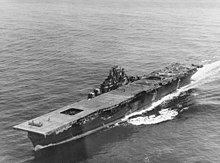USS Franklin (CV-13)
The keel of Franklin was laid down on 7 December 1942 in Shipway 11, the first anniversary of the attack on Pearl Harbor, and she was launched by the Newport News Shipbuilding Company, in Virginia, on 14 October 1943, sponsored by Lieutenant Commander Mildred H. McAfee, an American naval officer who was the Director of the WAVES.
[7] Among the plankowners was a ship's band made up of several enlisted men who were professional musicians at the time, including Saxie Dowell and Deane Kincaide, assigned to Franklin by a lottery.
Franklin steamed south to Trinidad for a shakedown and soon thereafter, she departed in Task Group 27.7 (TG 27.7) for San Diego, to engage in intensive training exercises preliminary to combat duty.
A period of upkeep and recreation from 9–28 August ensued at Eniwetok before she departed with Enterprise, Belleau Wood and San Jacinto for neutralization and diversionary attacks against the Bonins.
From 31 August to 2 September, strikes from Franklin inflicted ground damage, sank two cargo ships, destroyed enemy planes in flight, and undertook photographic surveys.
On 15 September, Franklin was attacked by three enemy planes, one of which scored with a bomb that hit the after outboard corner of the deck edge elevator, killing three men and wounding 22.
As further enemy threats seemed to materialize in another quarter, Franklin – with TGs 38.4, 38.3, and 38.2 – sped to intercept the advancing Japanese carrier force and attack at dawn.
Franklin's strike groups combined with those from the other carriers on 25 October in the Battle off Cape Engaño to damage Chiyoda (she would be sunk by American cruiser gunfire subsequently) and sink Zuihō.
Retiring in her task group to refuel, she returned to the Leyte action on 27 October, her planes concentrating on a heavy cruiser and two destroyers south of Mindoro.
Navy fighters shot down most of the Japanese planes, but six broke through the combat air patrol into Franklin's task group of four carriers defensively surrounded by a circle of about twenty escorting cruisers and destroyers.
As the remaining two kamikazes attacked, one was shot down by anti-aircraft guns and the second missed Franklin with two bombs before flying into the stern[9] of Belleau Wood.
After a stop for provisions, she departed from Pearl Harbor on 3 March 1945[12] to join TG 58.2 for strikes on the Japanese homeland in support of the Okinawa landings.
[7] Before dawn on 19 March 1945, Franklin, which had maneuvered to within 50 miles (80 km) of the Japanese mainland, closer than any other U.S. carrier during the war, launched a fighter sweep against Honshū and later a strike against shipping in Kure Harbor.
As Franklin was about halfway through launching a second wave of strike aircraft, the Japanese dive bomber pierced the cloud cover and dropped two semi-armor-piercing bombs before the ship's anti-aircraft gunners could fire.
On the bridge, Captain Gehres ordered Franklin's magazines flooded but this could not be carried out as the ship's water mains were destroyed by the explosions or fire.
Among the dead was one of the ship's surgeons, LCDR George W. Fox, M.D., who was killed while tending to wounded sailors; he was awarded the Navy Cross posthumously.
[21][22] When totaling casualty figures for both Franklin cruises numbers increase to 926 killed in action, the worst for any surviving U.S. warship and second only to that of battleship USS Arizona.
Among these were the Medal of Honor recipients Lieutenant Commander Joseph T. O'Callahan, the warship's Catholic chaplain, who administered the last rites, organized and directed firefighting and rescue parties, and led men below to wet down magazines that threatened to explode; and also Lieutenant Junior Grade Donald A. Gary, who discovered 300 men trapped in a blackened mess compartment and, finding an exit, returned repeatedly to lead groups to safety.
In History of United States Naval Operations in World War II, Samuel Eliot Morison gives figures of 724 killed and 265 wounded for 19 March 1945.
[27][28] Franklin suffered the most severe damage and highest casualties experienced by any U.S. fleet carrier that survived World War II.
[30][31] Among these were a gold star in lieu of a third Navy Cross for CDR (later RADM) Joseph F. "Joe" Taylor, the ship's executive officer and a former torpedo bomber pilot,[32] and Navy Crosses for CAPT (later RADM) Harold C. Fitz, the Santa Fe commander,[33] CDR Stephen Jurika, the Franklin navigator and also a former torpedo bomber pilot,[34] LCDR (later RADM) Dwight L. Johnson, the Miller commander,[31] LCDR Macgregor "Mac" Kilpatrick, an experienced fighter pilot and the commanding officer of Fighting Squadron Five,[35] and LT Fred R. "Red" Harris, a Franklin flight deck officer and a member of the Texas Legislature both before and after the war.
[36][37] Among those who received Silver Stars were LT Grimes W. Gatlin, the ship's other chaplain and a Methodist minister,[38] and Donald H. Russell, a civilian Corsair technical support engineer.
The enormous quantities of water poured aboard her to fight the fires further reduced freeboard, which was exacerbated by a 15-degree list to starboard, and her stability was seriously impaired such that her survival was in jeopardy.
After six hours, with the fire finally under control such that the ship could be saved, men returned to the engineering spaces and got underway at 25 kn (46 km/h; 29 mph) with only two of the four screws driving.
[40] After temporary repairs were completed, the ship continued its journey through the Panama Canal to the Brooklyn Navy Yard, New York, where she arrived on 28 April 1945.
[42] The Navy initially sold Franklin to the Peck Iron and Metal Company of Portsmouth, Virginia, but reclaimed her because of an urgent Bureau of Ships requirement for her four turbo generators.






